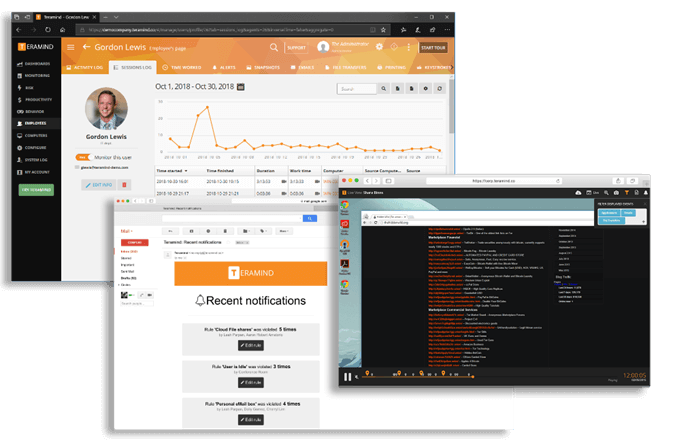Software for monitoring employees is a kind of software used by businesses to monitor and track employees’ activities. Employers can collect information on employee activities including Internet usage keys, app usages, keystrokes or even screen shots. Software for employee monitoring is mostly used to increase productivity, monitor the compliance with company policies, safeguard sensitive information and address security issues. When selecting an employee-monitoring software, there are many factors to consider. Remember these essential points: Features- Determine which specific features you require based on the requirements of your organization. Common features include: activity monitoring (including blocking websites) and keystroke logging (including the tracking of usage on applications) as well as email monitoring and reporting. You should prioritize only those features that are pertinent to your monitoring requirements.
Compliance and Privacy. Ensure that your software complies with all applicable moral and legal guidelines. You should familiarize yourself with all applicable laws in your area of. For example data protection laws, as well as privacy laws. You should look for software that is flexible and transparent features to respect the privacy rights of employees.
User-Friendliness. Think about the user-friendliness and the accessibility of the software. An easy-to-use user interface and easy installation will help you save time and ease of implementation. Consider a dashboard that is customizable and intuitive tools for reporting which allow you to quickly browse and analyze the data you have collected.
Integrity and compatibility- Check that the application is compatible with your current IT infrastructure, including the operating system or email client, the project management software and collaboration platforms. The compatibility ensures that you can monitor your business without disrupting day-to-day operations.
Data Security- Examine the security measures of your software in order to ensure the safety of the collected data. Access controls, encryption and secure storage of data and conformity to industry-standard security protocols are vital. Make sure the software vendor is known for its strong data protection track record and has strong security measures.
Scalability - Take into account the capacity of the software to expand with your business. Select a program that can easily expand to meet the needs of your organization in the event of adding more employees or new locations.
Analytical Reporting: Check the software's report and analytics capabilities. Features that provide a comprehensive view into the productivity of employees, their time management, and trends are essential to search for. Analytics and reports that can be customized to help you make better decisions and pinpoint areas for improvement.
Customer Support - Assess the quality of customer support offered by the vendor. Verify their availability and technical support. When problems arise, good customer service ensures that you receive prompt assistance.
Cost- Pay attention to the pricing structure for the program. It could be a one-time fee, subscription based or usage based. Know the price and whether there are any extra charges for support, upgrades, or other features. Try to balance the price of your product against its features and value.
Transparency and Communication with Employees Transparency and Communication with Employees - Inform your employees on the introduction of monitoring software. Be clear about the goal the scope and expectations regarding the monitoring. Discuss any concerns that they may have and assure them of the respect for their privacy.
When you look at these aspects it is possible to make a well-informed decision that fits your organization's specific needs and respects employee privacy while meeting all lawful requirements. Read the best employee monitoring software for blog info.
What Are The Different Characteristics Of The Employee Monitoring Software?
The software provides a variety of features that allow users to analyze and monitor employee activity. The specific features can differ across different software solutions Here are a few typical features that are found in all the employee monitoring software: Activity MonitoringThis feature records and logs employee activities, including sites visited, apps used, files accessed, and time spent in each job. It provides a complete summary of what employees are doing during their work hours.
Keystroke Logging: Keystroke logs record every keystroke that employees make. It can detect productivity bottlenecks and also identify unauthorized actions and collect evidence to aid investigations.
Screenshots and Screen RecordingScreen Recording and Screenshots - Certain software can capture screenshots of employee computer screens on a regular basis or records the screens of employees in real time. This can be useful to monitor productivity levels or troubleshooting.
Internet Usage Tracking - This feature tracks employees' internet activities, such as the websites they visit, searches, and downloads. It helps detect inappropriate browsing or security threats.
This feature tracks all applications that employees use in the workplace. It allows you to see which applications are the most popular and can help determine excessive or inappropriate use of the application.
Email Monitoring - Email monitoring allows employers to keep track of employees' emails, which include sent and received messages attachments, emails, and other the content of emails. It can help ensure the compliance of company policies, prevent data leaks, and investigate any suspicious activities.
Tracking of Documents and Files This feature monitors file changes and access. It secures sensitive information as well as monitors collaboration between documents and ensures that the document is in compliance with the data security policies.
Remote Monitoring allows employers to monitor employees that work remotely or in different locations. Employers are able to monitor their activity and ensure the efficiency of employees regardless of where they are.
Productivity Analysis: Employee monitoring software usually includes productivity analysis tools that provide insight into the productivity of employees as well as work patterns and time allocation. These analyses help find areas for improvement and optimize workflow.
Analytics and Reporting - Rich reporting and analytics tools generate precise reports that include visualizations of the data collected. These reports provide important information on the performance of employees, their the allocation of time and resources.
Compliance and Policy Management - Software solutions can be configured to comply with company policies, regulations, and other industry standards. They allow employers define and enforce company policies regarding acceptable use of computers.
Alerts and notifications- Alerts or notifications inform managers or employers of certain activities or events. For example they might alert employees about excessive Internet usage, attempts at accessing restricted websites, and unusual behaviour.
It is important to be conscious that various employee monitoring software may have different features and functionalities. When choosing software make sure you select features that match your monitoring needs and comply with your local ethical and legal guidelines. Follow the most popular time tracking monitoring services for more recommendations.

What Software For Employee Surveillance Adhere To Privacy And Compliance Laws? Privacy Law?
Software used to monitor employees must adhere to laws regarding privacy and compliance. Employee monitoring software must adhere to specific laws regarding privacy and compliance. While they may differ according to the jurisdiction however, a few of them are generally accepted. Employee monitoring programs often include features that enable employers to clearly communicate monitoring policies with employees. This is accomplished through the use of written notices sent to employees, obtaining their consent through consent forms or creating guidelines for monitoring in a manual.
Transparent Monitoring Polices - Employee monitoring tools help promote transparency. They make sure that employees understand what types of information are being collected and why, as being aware of the extent of monitoring. Clear and comprehensive policies help employees understand the boundaries of monitoring and their rights in relation to privacy.
Data minimization is typically employed by employee monitoring software to ensure compliance with privacy laws. The software collects and retains only what is necessary, and avoiding irrelevant or excessive data. This software helps to reduce security risks for privacy by collecting only data that is needed to monitor.
Anaonymization and Aggregation Some software for monitoring employees anonymizes data, or aggregates it to protect employee privacy. Anonymization eliminates all personally identifiable data (PII) and is unable to link data to individuals. Aggregation combines data from multiple employees to provide insights at an aggregate level, without single out individuals.
Encryption and Secure Data storage - Employee monitoring software places the highest priority on data security. Secure encryption and storage of data are employed to guard data against unauthorized access or disclosure by accident. This includes the security of data while in transit and at home.
Access Controls and Restricted Permissions Monitoring software for employees provides access control with greater granularity to ensure compliance. This enables employers to restrict the number of authorized users who are able to access the monitoring data, for example HR personnel or designated administrator.
Rights of Employees RightsRespecting the rights of employees means adhering to compliance and privacy laws. Software for monitoring employees typically includes features that permit employees to access their personal monitoring data, request corrections or to make complaints. Employees have the option to seek recourse in case of privacy violation and to make use of their rights.
Conformity with Data Protection Regulations – Software to monitor employee performance is designed to comply with applicable regulations. For instance, the General Data Protection Regulations of the European Union and the California Consumer Privacy Acts of the United States. It is accomplished by implementing suitable measures to protect personal data, respecting data subjects rights, and ensuring the lawful use of data.
Apart from employing tools for monitoring employees businesses should also seek out legal experts and keep up-to-date on laws and rules in their jurisdiction. To comply with the privacy and compliance laws, a comprehensive approach is essential that goes beyond software. It should include specific policies and education for employees, as well continuous monitoring of compliance. Follow the recommended employee monitoring software for site info.
